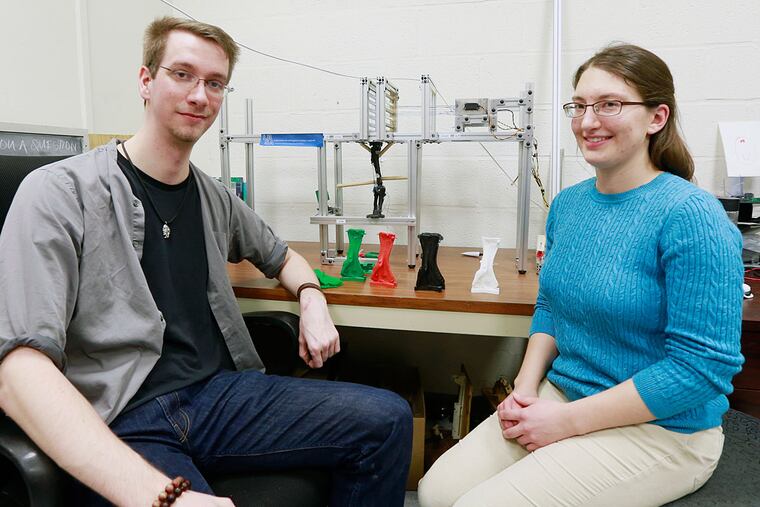How a 65-ton dinosaur took a power walk
Ever since a team led by Drexel University scientists found the bones of a dinosaur that weighed an estimated 65 tons, researchers have puzzled over how a creature that size got around.

Ever since a team led by Drexel University scientists found the bones of a dinosaur that weighed an estimated 65 tons, researchers have puzzled over how a creature that size got around.
Big muscles, for sure.
But the finer points of just how big, and where they were attached to the animal's massive bones, are unclear.
Drexel students Kristyn Voegele and David McDevitt are trying to solve this ancient mystery with a modern tool: 3-D printing. For starters, they have made a one-tenth scale model of the animal's left foreleg, complete with motors and steel cables to simulate the muscles.
"What we are trying to work toward is a better understanding of what was possible," said Voegele, in the final year of her Ph.D. in paleontology.
The dinosaur in question, Dreadnoughtus schrani, created an international sensation when its discovery, in the Patagonia region of Argentina, was announced in 2014.
It is unusual both for its size - still said to be the heaviest land animal for which a weight can be accurately calculated - and the number of bones recovered. A research team led by Kenneth Lacovara, who is now at Rowan University, unearthed 70 percent of the animal's skeleton, not counting the skull.
Among them was the 63-inch-long humerus - a wide slab of bone in the foreleg that calls to mind the blade of a snowplow.
In McDevitt and Voegele's scale model, this upper "arm" bone is reduced to a shade over 6 inches long, making it an easily adaptable research tool.
If they want to modify how the model bone is attached to the cables that simulate the animal's muscles, the researchers can simply tweak their design and "print" out the bone again. Ditto for the other two bones that are part of their initial model: the radius and ulna.
The dimensions for the models come from laser scans of the actual bones, which are now back in Argentina after spending a few years at Drexel and other U.S. universities. The data are fed to a 3-D printer, which has a nozzle that travels back and forth, squirting out layer after layer of plastic.
The bones are then fitted together inside a testing rig designed by McDevitt, a Drexel senior who works in the mechanical engineering lab of associate professor James Tangorra. If something seems a bit off with how one of the bones is attached, quick fixes are easy.
"By the next day, I could have a new one printed and ready to put in the device," McDevitt said.
In addition to the physical model of the foreleg, Voegele has created a computer simulation. The physical and virtual versions inform each other, illustrating how each might be modified to better approximate real life, she said.
In deciding where to attach the cables to the model bones, Voegele sought guidance from the real thing. Because this dinosaur's bones were so well preserved, they revealed actual scars where the tissues were attached, said Lacovara, dean of Rowan's School of the Earth and Environment.
"You can see the size of these scars, and you can also see the depths at which they are incised into the bone," he said.
Voegele also took cues from the anatomy of modern birds and crocodiles.
While her doctoral work is focused on the foreleg, other researchers can later add on additional limbs. That might help answer another question: why this dinosaur and its fellow "titanosaurs" walked with their legs splayed apart.
Fossilized footprints suggest that some other large dinosaurs walked with a narrow gait, like modern elephants and humans. But Dreadnoughtus had a wide gait more like that of a crocodile or bulldog. No one knows why.
A wide stance would provide more stability, but it comes at a cost, placing more torque on the animal's joints, said Jeffrey A. Wilson, associate professor in the University of Michigan's department of earth and environmental sciences.
"It's not as energetically efficient, but it's more stable," Wilson said.
Wilson thinks the wide stance is not connected to size, as there were other big dinosaurs with narrow stances, as well as smaller dinos with wide gaits.
Another possibility: Could the stance have something to do with the terrain where the animals walked?
Tangorra's lab, where the model dino leg is located, is home to numerous other devices that he and his students have fashioned to simulate various creature features. Mechanical fish fins are a common theme, with an eye toward developing better underwater robots for human use.
Voegele said maybe her dinosaur work could lead to better ways of supporting large machines.
But for now, she and McDevitt say they are happy simply to satisfy their intellectual curiosity about the big beast and how it roamed the earth.
"We may never know," McDevitt said. "And that's what's so exciting about it."
215-854-2430@TomAvril1